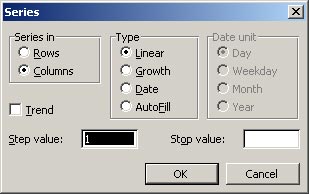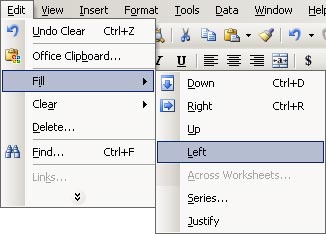MS Excel 2003 - Lesson 3: Manipulating data in spreadsheets
1, Default Font Format for spreadsheets
The previous article TipsMake.com has guided you to some basic formatting for a small data area, but if you need to format a large area or the default format for a new Excel 2003 file, follow these instructions. .
a, Default Font Format
- Go to Format -> Style .

With the following formats:
- Style name : name the type of attribute you use.
- Style includes : list with the required format properties
- Modify . : edit the format properties
- Add : click Add to save the changes needed in a style.
- Delete : Delete an unnecessary style.
b, Black out the spreadsheet
- Black out the entire worksheet : Click on the empty square to intersect the line title and column header.

- Apply black lines or black out columns : click on the name of the row or column to be highlighted
2, Automatic numbering
Some ways to number automatically:
a, Option 1 (this way can be applied to non-consecutive numbers):
- Enter the first 2 numbers of the sequence
- Blacken the two cells entered
- Move the cursor to the lower right of the highlighted area (place the cursor like copying the formula: the mouse pointer is a black plus sign)
- Hold down the mouse and drag to the required number.

Note : You can drag the number sequence from top to bottom, from the bottom up, from the left and from the right. Also, in this way, you can number non-interconnected numbers (sequences with arithmetic progressions).
b, Method 2 :
- Enter the first number of the sequence
- Put the mouse pointer in the lower right corner of the cell just entered
- Hold down Ctrl + drag the number to enter
Because dates are a special form of numeric type, if you want to quickly fill in dates, you can also use the above methods.
3, Fill numeric values on a region
Excel spreadsheets allow you to fill numeric values into a predefined data area (with this feature you can also enter numbers automatically)
- Enter the value in the first box
- Apply black areas to fill (can be column or row or region)
- Go to Edit -> Fill -> Series .

- Series in :
- Rows: Enter the value in line
- Columns: Enter values in columns
- Type :
- Linear: linear (vertical or horizontal)
- Growth: Enter the sequence of numbers exponentially
- Date: enter the date value
- AutoFill: Automatically enter the number or date according to Step value of 1
- Date unit : applies only to the date type value
- Day: sequentially increasing, decreasing by day
- Weekday: sequentially increase, decrease by working day of the week (except on Saturdays and Sundays)
- Month: sequential increase, decrease by month
- Year: sequential increase, decrease year by year
- Step value : type in the jump value (negative number: the jump is reduced, the number is positive: the step jumps
- Stop Value : the maximum value of the sequence
Also you can fill the values faster without entering the Series dialog: Go to Edit -> Fill

- Down : Fill down
- Right : Fill right
- Up : Fill up
- Left : Bright left
( Also )
You should read it
- MS Excel 2003 - Lesson 8: Excel Macro - Automate complex tasks
- How to number pages in all versions Excel (update 2020)
- Instructions to stamp negative numbers in Excel
- How to change the file extension XLSX to XLS to open in Excel 2003
- Number pages in Word 2003, insert special characters, date and time into Word
- How to arrange incremental dates in Excel
- Instructions on how to fix reverse dates in Excel
- Change the slash to a dot in Excel format
May be interested
- Work with data in Access 2016
 in the previous lesson, you became familiar with the access 2016 interface as well as the opening and closing of the basic database. this article will continue to go deeper into access 2016 around the content of working with data in access 2016.
in the previous lesson, you became familiar with the access 2016 interface as well as the opening and closing of the basic database. this article will continue to go deeper into access 2016 around the content of working with data in access 2016. - Excel 2016 - Lesson 11: Check spelling in Excel spreadsheets
 let's refer to the instructions for checking spelling on excel 2016 spreadsheets in this article with tipsmake.com!
let's refer to the instructions for checking spelling on excel 2016 spreadsheets in this article with tipsmake.com! - Excel 2016 - Lesson 7: Formatting Excel spreadsheets - Complete guide to Excel 2016
 if you have read the article about microsoft word, you must have grasped some basic knowledge about text alignment. let's refer to the article on formatting spreadsheet data in excel 2016 in this article!
if you have read the article about microsoft word, you must have grasped some basic knowledge about text alignment. let's refer to the article on formatting spreadsheet data in excel 2016 in this article! - Tips for manipulating Excel 2007 and 2010
 excel is the most popular spreadsheet processing software available today because it addresses most basic and advanced needs. besides equipping you with the necessary knowledge, the following article will provide some tips to help you work better on this powerful tool.
excel is the most popular spreadsheet processing software available today because it addresses most basic and advanced needs. besides equipping you with the necessary knowledge, the following article will provide some tips to help you work better on this powerful tool. - 8 Excel Spreadsheet Tips for Teams
 there are some tricks for members working together on an excel spreadsheet to find specific information and how to process the content so as not to confuse other members. here are some tips for working in a group in an excel spreadsheet.
there are some tricks for members working together on an excel spreadsheet to find specific information and how to process the content so as not to confuse other members. here are some tips for working in a group in an excel spreadsheet. - Complete guide to Excel 2016 (Part 9): Working with multiple spreadsheets
 excel workbook file is a collection of spreadsheet types (can contain from 1 to 255 spreadsheets) such as: data, graphs, macro, . and often related to each other.
excel workbook file is a collection of spreadsheet types (can contain from 1 to 255 spreadsheets) such as: data, graphs, macro, . and often related to each other. - Instructions for formatting data in Excel
 excel spreadsheets support a variety of data types for cells in the worksheet: numeric, percentage, date, time, fraction, etc., with different data, you should format the data type correctly. for that data box. so when calculating or processing data
excel spreadsheets support a variety of data types for cells in the worksheet: numeric, percentage, date, time, fraction, etc., with different data, you should format the data type correctly. for that data box. so when calculating or processing data - 5 source to get macro to automate Excel spreadsheets
 macros can help eliminate simple tasks from the workflow and allow users to take time to focus on more important issues.
macros can help eliminate simple tasks from the workflow and allow users to take time to focus on more important issues. - Extract Excel content into image format
 there is a lot of data on excel spreadsheets you want to turn into images for use in word documents or for sharing with everyone. instead of taking pictures of data on excel spreadsheets and editing to get images that contain data content, you can t
there is a lot of data on excel spreadsheets you want to turn into images for use in word documents or for sharing with everyone. instead of taking pictures of data on excel spreadsheets and editing to get images that contain data content, you can t - Manipulating tables in Excel
 guide you to create tables in excel. to create the table you perform the following steps: step 1: go to the insert - tables - table tab: step 2: the create table dialog box appears - in the where is the data for your table section select the data area to create the table - ok .
guide you to create tables in excel. to create the table you perform the following steps: step 1: go to the insert - tables - table tab: step 2: the create table dialog box appears - in the where is the data for your table section select the data area to create the table - ok .










 Set password protection file not open and save content edit
Set password protection file not open and save content edit Set password to protect text file content but still be readable (Office 2003)
Set password to protect text file content but still be readable (Office 2003) Change some options in MS Word
Change some options in MS Word Welcoming the new year with sweet letters
Welcoming the new year with sweet letters Use antivirus protection in Outlook Express 6
Use antivirus protection in Outlook Express 6 New points in Microsoft Office Word 2007
New points in Microsoft Office Word 2007